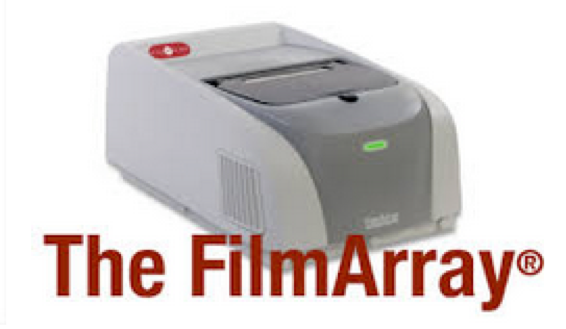Many institutions are now using a new multiplex machine to get instant diagnosis in encephalitis cases. Unfortunately, this system cannot identify cases of inherited chromosomal integration, creating confusion on how to follow up on positive cases.
The FilmArray meningitis/encephalitis panel can identify 14 central nervous system pathogens in cerebrospinal fluid (CSF), including 6 bacteria, 1 fungal species, and 7 viruses. So far, three studies using this detection method have been published with 1.9-2.7% of encephalitis patients testing positive for HHV-6. Since the prevalence of ciHHV-6 is around 0.8% in controls and 1.5-2% in patients (Pellett 2012), the bulk of the positive patients were likely to be ciHHV-6+. None of the studies did routine follow-up testing on all positive samples to determine ciHHV-6 status.
In the most recent FilmArray study, which was conducted in the UK, HHV-6 was the second most common pathogen found, in 8/345 (2.3%) patients. Of the 9 HHV-6+ samples, 7 were identified in CSF without pleocytosis, and all patients with acellular CSF and FilmArray positivity were under 7 months old.
Previously, the FilmArray detected HHV-6 among 2.7% of CSF samples from pediatric patients (Leber 2016). A more recent study using the FilmArray panel found HHV-6 in 1.9% of all samples (Green 2018). In this report, pleocytosis was observed in only 3/15 HHV-6+ samples, and HHV-6 was detected in the plasma of 7 out of 11 HHV-6+ subjects tested. 3 patients were found to be ciHHV-6+, although not all patients were tested, and 1/2 HHV-6+ encephalitis cases were ciHHV-6+. 7/15 had seizures, 7/15 had altered mental status, 3/15 had fever, and just one patient was considered to have HHV-6- associated encephalitis.
HHV-6 can be found in CSF in cases of HHV-6-associated encephalitis, encephalopathy, or febrile seizures, which most often occur during primary infection or in immunocompromised adults (Ongrádi 2017).
In studies using standard qPCR, the rate of HHV-6 positivity was much higher. A 4.2% detection rate of HHV-6 in the CSF of children under 14 with a suspected viral infection of the central nervous system has been described (Parisi 2016), and 8.8% of children 2 years of age or younger with encephalitis-like symptoms were HHV-6+ in another study (Yavarian 2014).
Among one cohort of 35 adult patients with clinical encephalitis who tested negative for other commonly associated pathogens, 40% had detectable HHV-6 in their CSF, while controls with other neurological diseases, including stroke, multiple sclerosis, and schizophrenia, were uniformly negative (Yao 2009).
ciHHV-6 status can be determined in most cases by testing for HHV-6 in whole blood or PBMCs, since the viral load in ciHHV-6 individuals is always >log 5.5 (Pellett 2012), which is far higher than typical encephalitis cases. ciHHV6 status can also be confirmed by a qualitative test of hair follicles or finger nail clippings.
The FilmArray ME panel decreases diagnostic delay and increases efficiency, as it has a turnaround time of approximately 1 hour and can detect a range of pathogens. This may result in reduced administration of unnecessary antibiotics, improved pathogenic targeting, and better patient care.
Find the full paper here: Lumley 2018.

